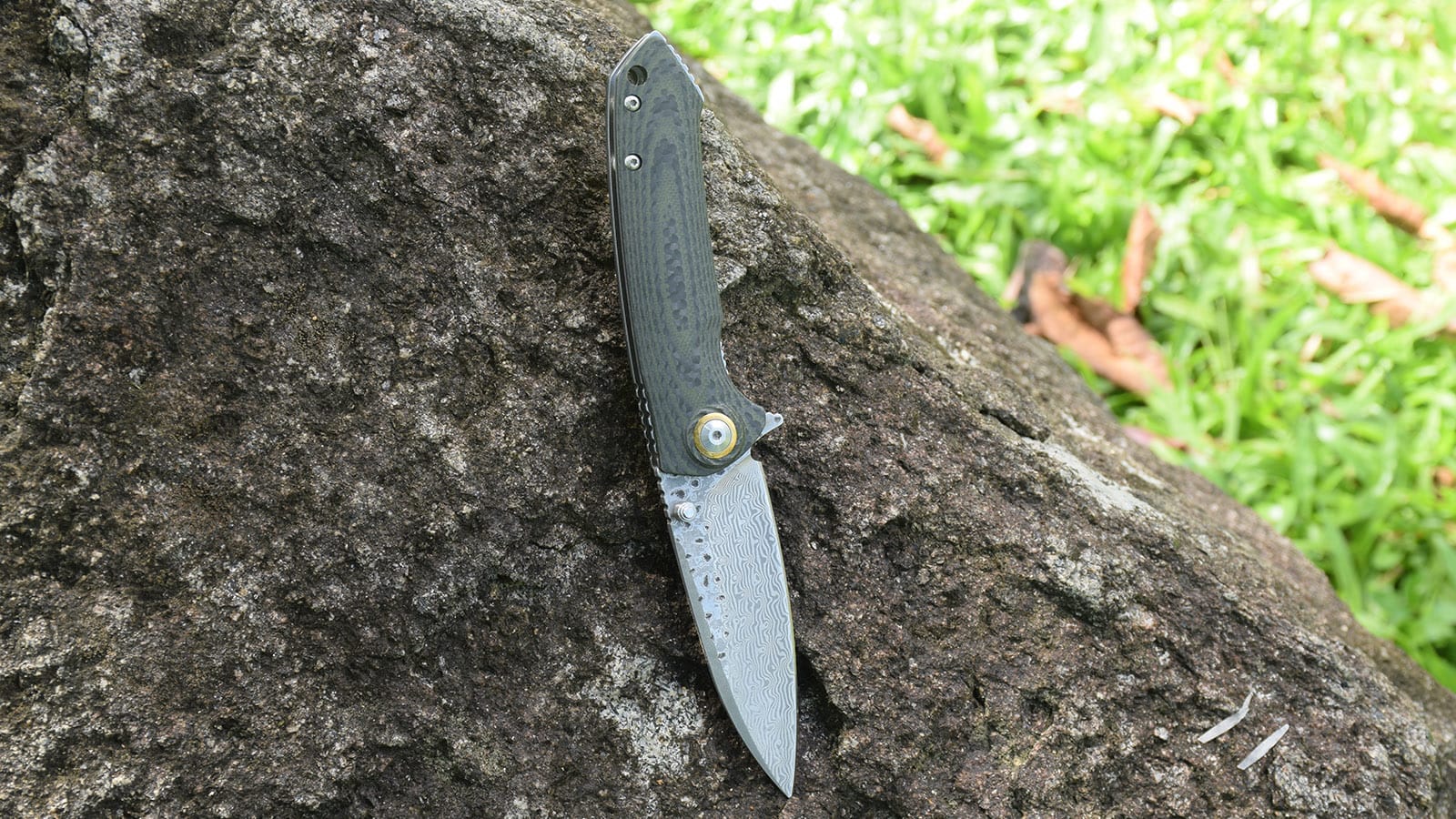Nože z damaškové oceli jsou známé pro své ohromující vzory a výjimečnou ostrost. I ty nejjemnější čepele však potřebují pravidelnou údržbu, aby zůstaly ve špičkovém stavu. Tento komplexní průvodce vás provede procesem broušení nože z damaškové oceli a zajistí, že zůstane ceněným nástrojem ve vaší kuchyni nebo při dobrodružstvích venku. Ať už jste ostřílený kuchař nebo nadšenec do nožů, zvládnutí této dovednosti vám pomůže zachovat krásu a funkčnost vaší damaškové čepele pro nadcházející roky.
Čím jsou nože z damaškové oceli výjimečné?
Nože z damaškové oceli jsou jedinečné svou konstrukcí a vzhledem. Tyto čepele jsou kované kombinací různých druhů oceli dohromady, vytvářející výrazný vlnitý nebo melírovaný vzor. Výsledkem tohoto procesu je nejen vizuálně výrazný nůž, ale také přispívá k jeho výjimečné pevnosti a zachování ostří. Kombinace tvrdých a měkčích ocelí v damaškových čepelích však vyžaduje zvláštní opatrnost při broušení.
Proč je správné broušení u nožů z damaškové oceli klíčové?
Údržba ostří nože z damaškové oceli je nezbytná z několika důvodů:
- Zachovává jedinečný vzor Damašku
- Zajišťuje optimální řezný výkon
- Prodlužuje životnost vašeho nože
- Udržuje strukturální integritu čepele
Zanedbání správného nabroušení damaškového nože může vést k otupení ostří, snížení výkonu a potenciálnímu poškození složitého vzoru čepele.
Jak často byste měli brousit nůž z damaškové oceli?
Frekvence broušení závisí na tom, jak často nůž používáte a k čemu jej používáte. Zpravidla:
- Pro běžné domácí použití: Ostřete každé 2-3 měsíce
- Pro profesionální kuchyňské použití: Ostřete jednou týdně nebo jednou za dva týdny
- Pro příležitostné použití: Ostřete každých 6 měsíců
Pamatujte, že je lepší nůž pravidelně brousit a brousit méně často než přeostřování, které může čepel zbytečně opotřebovat.
Jaké nástroje potřebujete k nabroušení nože z damaškové oceli?
Chcete-li svůj nůž z damaškové oceli efektivně naostřit, budete potřebovat následující nástroje:
- Brousek (nejlépe sada s různými zrnitostmi)
- Honování oceli
- Čistý hadřík
- Voda nebo olej (v závislosti na typu brousku)
- Volitelně: Kožený řemen pro konečné leštění

Jaký je nejlepší způsob, jak se připravit na ostření?
Než začnete brousit nůž z damaškové oceli, proveďte tyto přípravné kroky:
- Čepel důkladně očistěte
- Zkontrolujte hranu, zda nevykazuje úlomky nebo poškození
- V případě potřeby brousek namočte (některé kameny je třeba ponořit do vody na 10-15 minut)
- Postavte si stabilní pracovní plochu
- Zajistěte dobré osvětlení, abyste jasně viděli ostří čepele
Jak určíte správný úhel pro ostření?
Správný úhel ostření je zásadní pro udržení ostří nože z damaškové oceli. Většina damaškových nožů má úhel 15-20 stupňů na stranu. Chcete-li najít správný úhel:
- Držte nůž kolmo ke kameni (90 stupňů)
- Nakloňte čepel do poloviny směrem ke kameni (45 stupňů)
- Nakloňte znovu do poloviny (22,5 stupně)
- Proveďte mírnou úpravu, abyste dosáhli rozsahu 15-20 stupňů
Udržování konzistentního úhlu během procesu ostření je klíčem k dosažení ostré a rovnoměrné hrany.
Jaký je postup krok za krokem pro broušení nože z damaškové oceli?
Při broušení nože z damaškové oceli postupujte takto:
- Začněte s hrubou zrnitostí vašeho brousku
- Držte nůž ve správném úhlu
- Lehce zatlačte a posuňte čepel po kameni od paty ke špičce
- Tento pohyb opakujte 10-15krát na každou stranu
- Přepněte na stranu s jemnějším zrnem a proces opakujte
- K vyrovnání hrany použijte honovací ocel
- Volitelné: Přiložte čepel na kůži pro konečné vyleštění
Nezapomeňte během celého procesu udržovat stejný úhel a používat hladké, konzistentní tahy.
Jak se můžete vyhnout poškození damaškového vzoru při ostření?
Chcete-li zachovat krásný damaškový vzor při ostření:
- Použijte mírný až mírný tlak
- Vyvarujte se agresivního broušení
- Ostřete ve směru vzoru, ne proti němu
- Pro většinu procesu ostření používejte jemnější zrnitost
- Během ostření čepel často čistěte, abyste odstranili kovové částice
Jakým běžným chybám se při broušení damaškové oceli vyhnout?
Buďte si vědomi těchto běžných úskalí:
- Použití příliš velkého tlaku
- Nekonzistentní úhel během ostření
- Přeostření
- Použití nevhodných ostřících nástrojů
- Zanedbávání čištění kotouče mezi zrny
- Zapomínání brousit čepel po naostření
Jak poznáte, že je váš nůž z damaškové oceli dostatečně ostrý?
Existuje několik způsobů, jak otestovat ostrost nože z damaškové oceli:
- Test papíru: Nůž by měl čistě proříznout list papíru
- Test rajčat: Nůž by měl snadno proříznout slupku rajčat bez tlaku
- Test ochlupení na paži: Nůž by měl být schopen oholit chloupky na paži (buďte velmi opatrní!)
Pokud váš nůž projde těmito testy, je pravděpodobně dostatečně ostrý pro většinu úkolů.
Jak můžete udržovat nůž z damaškové oceli mezi broušením?
Chcete-li zachovat svůj Nůž z damaškové oceli v top stavu mezi ostřením:
- Pravidelně používejte honovací ocel (před nebo po každém použití)
- Nůž řádně uložte do bloku na nože nebo magnetického proužku
- Ruční mytí a sušení ihned po použití
- Používejte vhodné řezné plochy (vyvarujte se skla nebo mramoru)
- Občas aplikujte potravinářský minerální olej, abyste zabránili korozi
Dodržováním těchto tipů pro údržbu prodloužíte dobu mezi nezbytnými broušeními a zachováte ostří a vzor nože. Závěrem lze říci, že broušení nože z damaškové oceli vyžaduje trpělivost, praxi a správnou techniku. Budete-li se řídit tímto návodem, budete schopni zachovat ostré ostří nože a zachovat jeho ohromující damaškový vzor. Pamatujte, že dobře udržovaný nůž z damaškové oceli není jen nástroj, ale umělecké dílo, které může vydržet po celý život. Klíčové body, které je třeba si zapamatovat:
- Při ostření používejte správný úhel (15-20 stupňů).
- Začněte s hrubšími zrny a pokračujte k jemnějším
- Během celého procesu udržujte stálý tlak a úhel
- Pravidelně honujte a řemínkem pro finální lesk
- Mezi jednotlivými použitími nůž řádně očistěte a uložte
- Pro zvládnutí umění broušení nožů je nezbytná praxe a trpělivost




